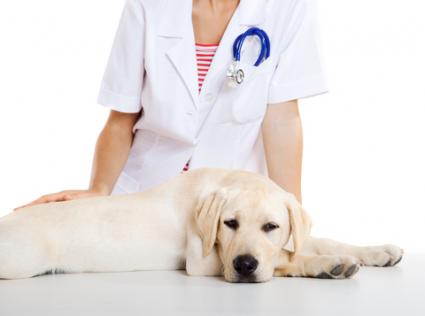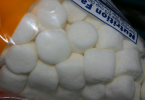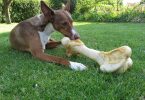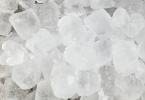Bloat in dogs is incredibly dangerous and potentially risky for all types of dogs. Not all dogs are vulnerable; albeit, some are more susceptible than others such as German Shepherds, Great Danes, and Doberman’s. Scientifically, bloat is called Gastric Dilatation Volvulus or in short GDV; today, it is the second biggest killer to contracting cancer.
What causes bloat in dogs?
Bloat in dogs is usually caused by swallowing air; genetics, hyperventilating, stress, non-stop sneezing, diet, eating habits such as consuming food too fast can also be responsible. As a rule of thumb, avoid giving your dog whole peas, never give onions or beans to a dog as these foods can produce an excessive amount of gas. Feed your dog high-quality food and invest in a slow feeding bowl, they are excellent; my dogs use them all the time.
For further reading on foods check out ‘Dog food ingredients debunked‘ – this will expose everything you have always wanted to know about dog food and brands; and what should and shouldn’t be added in your dog’s food. It is proven that high-good quality nutritious food can assist with bloat in dogs.
Hyperventilation through stress may generate an extreme amount of air, which can lead to difficulty in breathing, particularly for older dogs.
As the name suggests (bloat or dilatation), a dog’s stomach becomes bloated with air or fluid, this is repeatedly associated with a twisting (volvulus) or a gyrator of the esophagus and the duodenum.
The stomach can swell, and it can twist and rotate from 90 degrees to 360 degrees; consequently, dogs can experience incredible pain, and it can be life-threatening. The trapped air, fluid or food is literally stuck; nothing can escape the stomach because all valves are shut off. This causes the internal organs to swell and die, which can induce irreversible damage.
Bloat needs to be treated asap or it can kill with hours, if it is recognized and caught in time, it can be treated by a veterinarian. Once a dog has had this illness, he likely he’ll have it again, this is because his insides become weaker. Furthermore, with each episode, the pain becomes more unbearable and harder to treat. Please consult your vet if you are unsure about any illness.
Common signs and symptoms of bloat in dogs
Bloat in dogs is not obvious; especially, if you’re not accustomed to this illness. One sign of bloat in dogs is to look for unnecessary vomiting or the lack of ability to belch. If your dog is powerless to regurgitate for a few minutes, don’t fret as it may be nothing. However, if your dog has just consumed a meal and he’s trying to regurgitate, is very restless, collapsing, crawling, trying to hide, thirsty, foaming at his mouth and has a swollen hard stomach, then a visit to your vet is in order. Be prepared that your dog may need an elective gastropexy to correct his discomfort.
An extended stomach or bloating is another sign of bloat in dogs. This dilatation is a sign where the problem has reached its maximum, once it reaches this point, it is life threatening. You can feel your dog stomach in standing position; it ought to feel comparatively pliable and aligned with the body. If it’s hard, unmitigated or even sounds like a drum when you’re tapping it gently, it may well be bloat.
Bloat in dog’s cuts off the esophagus and the upper part of the intestines and trap anything inside the stomach. This can constrict the veins, cause low blood pressure, stress, shock, damage to the internal organs such as the heart and cause improper blood flow. Oxygen levels become reduced in the blood, the stomach cells can die; toxins and bacteria can go on a rampage throughout the bloodstream. Kidney failure is a possibility, and Cardiac Arrhythmia is often likely.
If your dog is susceptible to bloat, it’s wise to contact your vet and ask for some guidance and what products you could store in the house. Many owners stock up on products that contain simethicone for emergencies, which prevents gas build up.
Do’s and don’ts for bloat in dogs
Do Not Permit…
- Rapid drinking or eating
- Fermenting foods
- Stress
- Exercise at least one hour before and after eating
- Water one hour before and after eating
- Elevated food bowls
Do Permit…
- Constant fresh water using a non-spill bowl, this can encourage sipping instead of gulping.
- Indipets Bowl – This is an extra heavy one piece stainless steel non tipping bowl – It’s also classed as an anti skid health care slow feeding dish. You can buy something similar or even hand feed your dog.
- Peaceful meals
- High quality dog food
- Add ½ to 1tbsp of apple cider vinegar to food
- Add probiotics, fish oil and Aloe Vera
- Feed two to three meals






Leave a Comment